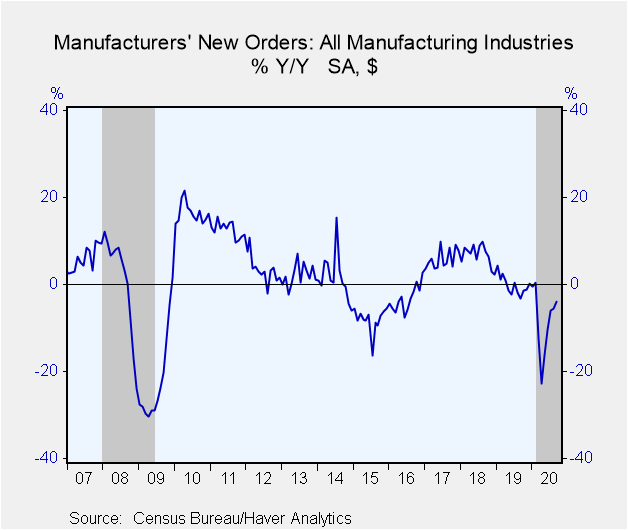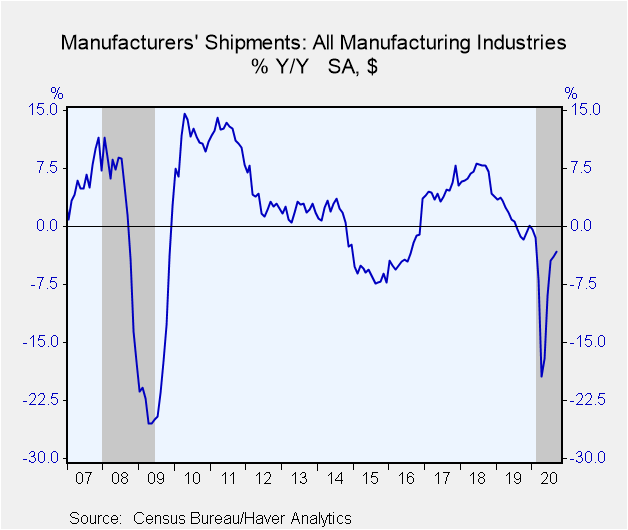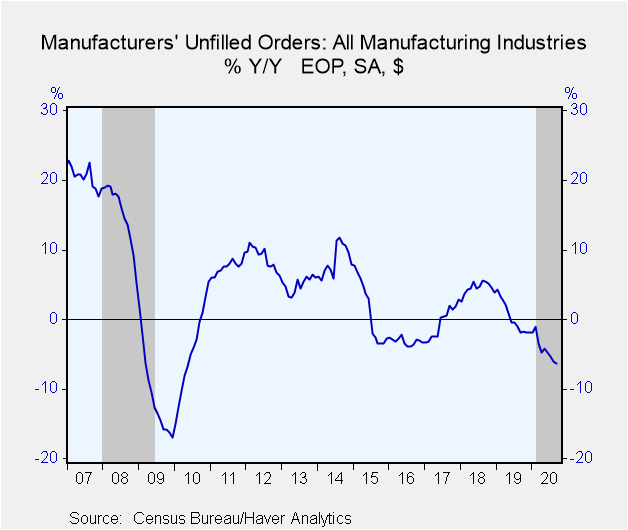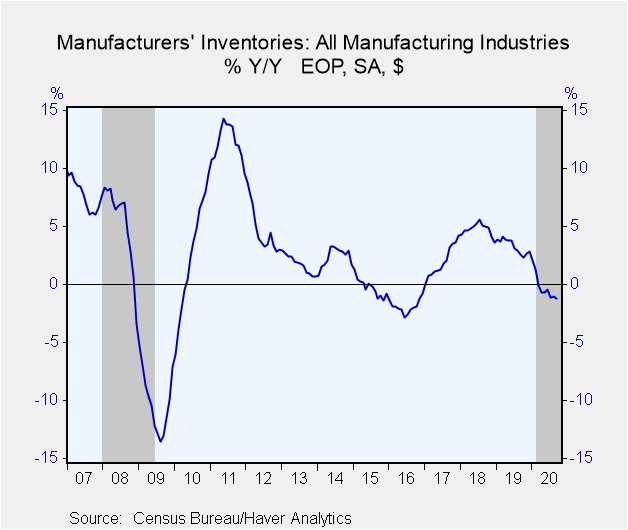 Global| Nov 03 2020
Global| Nov 03 2020U.S. Factory Orders Surge; Shipments Improve
by:Tom Moeller
|in:Economy in Brief
Summary
• Factory orders rise for fifth straight month. • Shipments gain steadily. • Order backlogs slip while inventories hold steady, again. Activity in the factory sector continues to recover. Manufacturers' orders strengthened 1.1% during [...]
• Factory orders rise for fifth straight month.
• Shipments gain steadily.
• Order backlogs slip while inventories hold steady, again.
Activity in the factory sector continues to recover. Manufacturers' orders strengthened 1.1% during September following a 0.6% August rise, revised from 0.7%. A 0.9% gain had been expected in the Action Economics Forecast Survey. The 3.9% y/y orders decline during September compares to a 5.9% y/y shortfall in factory sector production.
Orders in the durable goods sector improved 1.9% (-1.8% y/y), unrevised from last week's advance report. That followed a 0.4% August gain. Both increases were sharply below the gains logged early in the recovery. The rise was boosted by a 4.1% increase in transportation sector bookings as nondefense aircraft orders surged. Shipments of durable goods rose 0.4% (-0.5% y/y). For more details on the durable goods sector, see last week's report.
Factory shipments rose 0.3% (-3.3% y/y) in September for the second straight month. Nondurable goods shipments, which equal nondurable goods orders, increased 0.3% (-6.0% y/y) after rising 0.8% during August. Apparel shipments surged 4.9% (-2.5% y/y) following a 3.6% drop. Textile product shipments also were strong, posting a 2.7% rise (-6.1% y/y) after a 4.1% jump. Elsewhere, shipments were mixed. Food product shipments rose 0.3% (0.6% y/y) and paper product shipments edged just 0.1% higher (1.6% y/y). Shipments from petroleum refineries eased 0.1% (-29.1% y/y).
Unfilled orders of durable goods weakened 0.2% (-6.3% y/y), off for the sixth month this year. Transportation equipment backlogs fell 0.7% (-9.5% y/y). Excluding the transportation sector, unfilled orders increased 0.7% (0.9% y/y). Computer & electronic backlogs held steady (0.5% y/y) while machinery grew 0.6% (1.4% y/y).
Inventories of manufactured products were unchanged in September (-1.2% y/y) as durable goods inventories, which are roughly 60% of total inventories, rose 0.3% (0.6% y/y). Transportation increased 0.6% (8.2% y/y). Inventories outside of transportation edged down 0.1% (-3.6% y/y) for the second straight month. Nondurable goods inventories were off 0.5% (-4.0% y/y) as petroleum refinery inventories fell 6.2% (-21.7% y/y). Apparel inventories fell 0.6% (-3.7 y/y), off for the fifth strait month.
All these factory sector figures and West Texas intermediate oil prices are available in Haver's USECON database.
| Factory Sector (% chg) - NAICS Classification | Sep | Aug | Jul | Sep Y/Y | 2019 | 2018 | 2017 |
|---|---|---|---|---|---|---|---|
| New Orders | 1.1 | 0.6 | 6.5 | -3.9 | -0.1 | 6.8 | 5.9 |
| Shipments | 0.3 | 0.3 | 4.7 | -3.3 | 1.0 | 6.6 | 4.7 |
| Unfilled Orders | -0.2 | -0.6 | -0.7 | -6.3 | -1.8 | 3.9 | 2.8 |
| Inventories | 0.0 | 0.0 | -0.6 | -1.2 | 2.8 | 3.6 | 4.2 |
Tom Moeller
AuthorMore in Author Profile »Prior to joining Haver Analytics in 2000, Mr. Moeller worked as the Economist at Chancellor Capital Management from 1985 to 1999. There, he developed comprehensive economic forecasts and interpreted economic data for equity and fixed income portfolio managers. Also at Chancellor, Mr. Moeller worked as an equity analyst and was responsible for researching and rating companies in the economically sensitive automobile and housing industries for investment in Chancellor’s equity portfolio. Prior to joining Chancellor, Mr. Moeller was an Economist at Citibank from 1979 to 1984. He also analyzed pricing behavior in the metals industry for the Council on Wage and Price Stability in Washington, D.C. In 1999, Mr. Moeller received the award for most accurate forecast from the Forecasters' Club of New York. From 1990 to 1992 he was President of the New York Association for Business Economists. Mr. Moeller earned an M.B.A. in Finance from Fordham University, where he graduated in 1987. He holds a Bachelor of Arts in Economics from George Washington University.










